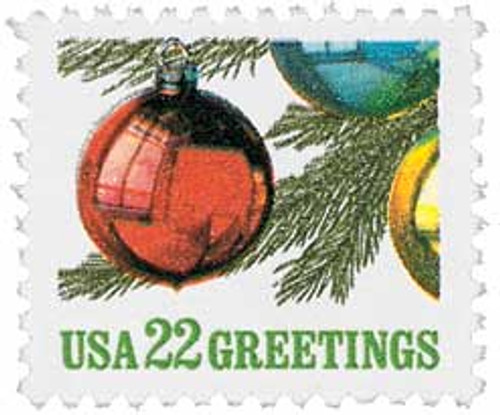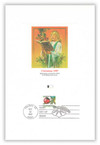
# 2368 - 1987 22c Contemporary Christmas: Ornaments on Tree
U.S. #2368
1987 22¢ Ornaments on Tree
Contemporary Christmas
- 23rd Contemporary Christmas issue
- Pictures three glass ornaments hanging on a tree
- First stamp issued at Disneyland in California
Stamp Category: Commemorative
Series: Contemporary Christmas
Value: 22¢, first-class rate
First Day of Issue: October 23, 1987
First Day City: Anaheim, California
Quantity Issued: 978,340,000
Printed by: Bureau of Engraving and Printing
Printing Method: Photogravure
Format: Panes of 100 in sheets of 800
Perforations: 11
Why the stamp was issued: For use on holiday mail.
About the stamp design: James Dean created the artwork for this stamp. His original painting shows red, blue, and gold glass ornaments hanging from a Christmas tree. Each of the ornaments has a reflection of the room – a window and furniture.
First Day City: The First Day ceremony for this stamp was held at Disneyland in Anaheim, California. It was the first time the USPS had a First Day ceremony at the park, and special covers and programs were designed by Disney artists.
About the Contemporary Christmas series: The US issued its first Christmas stamp (picturing a wreath and candles) on November 1, 1962, and it was wildly popular. The Post Office printed 350 million stamps, the largest print run for a special stamp up to that time, but still the stamps quickly sold out. The Bureau of Engraving and Printing produced more to satisfy demand and the total number issued was over 860 million by the end of the year.
In 1966, the Post Office started issuing traditional themed Christmas stamps picturing the Madonna and Child and other religious icons. In 1969, they switched back to non-religious Christmas designs with a stamp picturing the painting Winter Sunday in Norway, Maine.
Finally, in 1970, the Post Office decided to permanently split Christmas stamps into two categories to satisfy everyone: Traditional and Contemporary. They issued a block of four stamps picturing Christmas toys along with a stamp picturing a classic painting of the Nativity. The decision to do both proved popular, and the Post Office has continued to issue stamps in both categories ever since.
History the stamp represents: An abundance of clear water, sand, and timber made the town of Lauscha, Germany, the perfect location for skilled glassblowers to settle. In the 16th century, the Lauscha artists set up ovens in their homes. Over the next 300 years, families worked together to craft drinking glasses, bowls, and decorative beads.
In 1847, the glassblowers started making molded glass ornaments to sell at Christmas markets. The balls shimmered from silver that had been swirled inside. Decorations shaped like fruits, nuts, and intricate flowers were crafted. Their popularity grew quickly, and soon Christmas trees all over Germany were graced with these glass ornaments.
In Britain, decorated trees were not popular until the beloved queen was pictured with one. Queen Victoria married Prince Albert of Germany, who brought his Christmas traditions with him. After an English magazine pictured the royal family around their tree, every fashionable family in England and the U.S. had to have a tree of their own. When Lauscha’s glass ornaments were imported to England, they were an instant success.
Even today, expert glassblowers in Lauscha continue to create the delicate ornaments that became a Christmas tradition generations ago.
U.S. #2368
1987 22¢ Ornaments on Tree
Contemporary Christmas
- 23rd Contemporary Christmas issue
- Pictures three glass ornaments hanging on a tree
- First stamp issued at Disneyland in California
Stamp Category: Commemorative
Series: Contemporary Christmas
Value: 22¢, first-class rate
First Day of Issue: October 23, 1987
First Day City: Anaheim, California
Quantity Issued: 978,340,000
Printed by: Bureau of Engraving and Printing
Printing Method: Photogravure
Format: Panes of 100 in sheets of 800
Perforations: 11
Why the stamp was issued: For use on holiday mail.
About the stamp design: James Dean created the artwork for this stamp. His original painting shows red, blue, and gold glass ornaments hanging from a Christmas tree. Each of the ornaments has a reflection of the room – a window and furniture.
First Day City: The First Day ceremony for this stamp was held at Disneyland in Anaheim, California. It was the first time the USPS had a First Day ceremony at the park, and special covers and programs were designed by Disney artists.
About the Contemporary Christmas series: The US issued its first Christmas stamp (picturing a wreath and candles) on November 1, 1962, and it was wildly popular. The Post Office printed 350 million stamps, the largest print run for a special stamp up to that time, but still the stamps quickly sold out. The Bureau of Engraving and Printing produced more to satisfy demand and the total number issued was over 860 million by the end of the year.
In 1966, the Post Office started issuing traditional themed Christmas stamps picturing the Madonna and Child and other religious icons. In 1969, they switched back to non-religious Christmas designs with a stamp picturing the painting Winter Sunday in Norway, Maine.
Finally, in 1970, the Post Office decided to permanently split Christmas stamps into two categories to satisfy everyone: Traditional and Contemporary. They issued a block of four stamps picturing Christmas toys along with a stamp picturing a classic painting of the Nativity. The decision to do both proved popular, and the Post Office has continued to issue stamps in both categories ever since.
History the stamp represents: An abundance of clear water, sand, and timber made the town of Lauscha, Germany, the perfect location for skilled glassblowers to settle. In the 16th century, the Lauscha artists set up ovens in their homes. Over the next 300 years, families worked together to craft drinking glasses, bowls, and decorative beads.
In 1847, the glassblowers started making molded glass ornaments to sell at Christmas markets. The balls shimmered from silver that had been swirled inside. Decorations shaped like fruits, nuts, and intricate flowers were crafted. Their popularity grew quickly, and soon Christmas trees all over Germany were graced with these glass ornaments.
In Britain, decorated trees were not popular until the beloved queen was pictured with one. Queen Victoria married Prince Albert of Germany, who brought his Christmas traditions with him. After an English magazine pictured the royal family around their tree, every fashionable family in England and the U.S. had to have a tree of their own. When Lauscha’s glass ornaments were imported to England, they were an instant success.
Even today, expert glassblowers in Lauscha continue to create the delicate ornaments that became a Christmas tradition generations ago.










